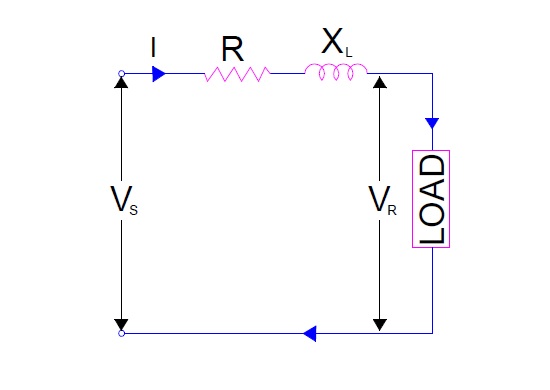We know that, Electric Power is transmitted using three phase transmission system due to its own advantages. But for any system it is very important to define some parameters to evaluate the performance. Therefore, there must be some parameters which define the performance of transmission line. Yes, there are two parameters namely, Voltage Regulation and Transmission Efficiency to determine the performance.
What is Voltage Regulation of Transmission Line?
Let us consider an equivalent circuit of short transmission line. Note that for short transmission line, shunt capacitance is neglected. This is the reason; short transmission line is represented only by series combination of line resistance and reactance as shown in figure below.
Vs = Sending end voltage
VR = Receiving end voltage
Is = IR = Current through the line
Z = Line impedance = R+jX
When transmission line is carrying current, there is a voltage drop across the impedance of the line. Due to this voltage drop, normally receiving end voltage is less than the sending end voltage. There is one exception where receiving end voltage is more than the sending end voltage. That exception is Ferranti Effect.
Suppose the line is unloaded. In this case the receiving end voltage and sending end voltage will be same as there is no current flowing through the transmission line to cause voltage drop. But as soon as there is a flow of current, there will be a voltage drop. Thus the voltage drop from no load to full load can be expressed as
Voltage drop = Receiving end voltage at no load – Receiving end voltage at full load
= (Vs – VR)
This drop in voltage at receiving end when expressed as percentage of receiving end voltage VR is known as Voltage Regulation of Transmission Line. Thus mathematically,
% Voltage Regulation = [(Vs – VR) x100/ VR ] %
Thus Voltage Regulation can be defined as, “the drop in receiving end voltage from no load to full load expressed as percentage of Receiving end voltage.”
For a transmission line, it is expected that receiving end and sending end voltage are same. Therefore, a better voltage regulation means a less voltage drop and hence lower value of voltage regulation.
It shall be noted that, short transmission line is assumed for the sake of better understanding of voltage regulation. Though, it is applicable for short, medium and long transmission lines.
What is Transmission Efficiency?
Efficiency is expressed in percentage. Transmission efficiency is a parameter which says how much percentage of input power at sending end is delivered to the receiving end. Let us suppose that, sending end power is Ps Mega Watt (MW) and Receiving end power is PR MW.
Then % transmission efficiency η = PRx100 / Ps %
But Ps = VsIsCosØs
and PR = VRIRCosØR
where CosØs = Sending end power factor
and CosØR = Receiving end power factor
Hence,
% Transmission Efficiency η= [VRIRCosØR / VsIsCosØs]x100%
Now the question arises, where did (100 – η)% of input power gone? Actually, transmission line has its own line resistance. So, there will be an ohmic loss in the resistance of line. If Ps is the input power at sending end, then only (Ps – Loss) will be available at the receiving end. Therefore (100 -η)% is the loss in transmission line resistance. This gives us a new method to calculate transmission efficiency. If we know the loss in the line then efficiency can be calculated as
% Efficiency η = [(Input Power – Loss) / Input Power]x100 %
= [(Ps – Loss) / Ps]x100 %
= [Ps/Ps – Loss/Ps]x100 %
= [1 – Loss/Ps]x100 %
So,
% Efficiency η = [1- I2R/Ps]
= [1- I2R / VsIsCosØs]
= [1- IR / VsCosØs] ..(since Is = I = current in transmission line)

Super bheya 9438782954
Superb
thank you